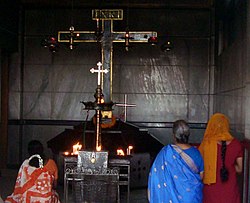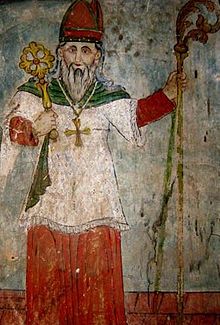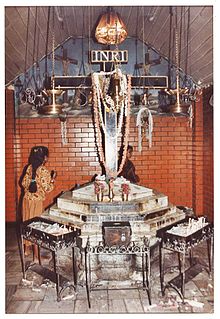Oath of the crooked cross
In the Oath of the Leaning Cross (Coonan or Coonen Cross Oath) in 1653, the Thomas Christians who were gathered at the "Coonan Cross" in Mattancherry , Cochin in what is now the state of Kerala , swore that they would no longer submit to the Latin Archbishop of Angamaly, who was dependent on Portugal, and the Jesuits , A few months later the group split into a Catholic and an autocephalous part. The event has a similar symbolic value in the Indian Church as Luther's posting of the theses in Germany.
Historical background
The Church in India is of apostolic origin. According to the constant local tradition, the apostle Thomas landed in Muziris (Kodungallur), in today's Kerala , in 52 , founded seven Christian communities along the Malabar coast and died a martyr in Mailapur near Madras . From this foundation the Church developed in India long before European colonial powers were active there. She followed the East Syrian liturgy. Before the arrival of the Portuguese and at the beginning of their colonial activity, the Indian metropolitans were sent by the Chaldean Patriarch of the Assyrian Church of the East . This patriarchy had long had a loose connection with Rome. Since Patriarch Mar Johann Shimun Sulaqa , consecrated bishop in St. Peter's Church in Rome in 1553, there has been a formal ecclesiastical union and the particular church under the Patriarch of Babylon is called the Chaldean Catholic Church .
Initially, the bishops sent to India by the Chaldean Catholic Patriarch in Babylon were accepted by the Portuguese colonial rulers the more they were able to establish their own rule there, but the more they were suppressed. As an additional means of pressure, the Thomas Christians were accused of the heresy of Nestorianism , since they obtained their bishops from the Chaldean Patriarch or, earlier, even from the Assyrian Church of the East . From 1556 to 1569, Mar Joseph Sulaqa , the biological brother of Patriarch Johann Shimun Sulaqa , served as the Syro-Catholic Metropolitan of Angamaly in India with papal legitimation . Cardinal Bernardino Maffei had already given a speech in the consistory of February 20, 1553 on the occasion of the impending award of the patriarchal dignity to Johann Shimun Sulaqua, in which he expressly attested to the so-called "Nestorians" in Seleukia-Ctesiphon and India; they only carry this designation, in reality they are completely orthodox.
Notwithstanding initiated Portugal in India who never Konfirmierte of Rome and today as "Robber Synod" classified synod of diamper . With the help of the constructed accusation of heresy, the subordination of the metropolitan seat of Angamaly as a suffragan to the Latin Archdiocese of Goa resulted in December 1599 . This in turn was under the sovereignty of Portugal; the archbishop was viceroy at the same time and bishops were only appointed there in agreement with the Portuguese crown. The last Archbishop of Angamaly appointed by the Chaldean Catholic Patriarch in India was Mar Abraham († 1597). He was followed by the Latin Jesuit archbishops Francis Roz SJ († 1624), Stephen Britto SJ († 1641) and Francis Garcia SJ († 1659). Archbishop Roz had moved the seat of the diocese from Angamaly to Cranganore (now Kodungallur). The Latin shepherds were alien to the Chaldean (= East Syrian) liturgy and tried to adapt it to their own Latin rite. The traditional rite - now called Syro-Malabar - was more or less strongly suppressed or Latinized.
The Oath of the Leaning Cross
The disputes between the Latin missionaries and the Thomas Christians culminated in the "Oath of the Leaning Cross" (Coonan Cross) in Cochin . This came about because Archbishop Francis Garcia von Angamaly appointed another Latin vicar general for them in addition to the traditional archdeacon . There were constant disputes between Archbishop Garcia and Archdeacon Thomas Parambil, the head and leader of the Thomas Christians. The latter longed for a bishop of their own rite, and for this purpose the archdeacon conducted extensive correspondence with the archbishop behind the back of the archbishop, which made the situation there widely known. During this time, in the spring of 1652 , a bishop named "Atallah" appeared in Surat , on the west coast of India . He came from Cairo , from the Coptic Patriarch of Alexandria, and claimed to be sent by the Pope to rule the Thomas Christians as Metropolitan of India. Bishop Atallah reached Mylapore in August that year and wanted to go to the Malabar Coast , what is now Kerala. However, the Portuguese held him in Mylapore and ultimately abducted him to Goa via Cochin . Archdeacon Thomas sent petitions to the secular and spiritual authorities of Cochin complaining that the Portuguese refused entry to a bishop sent by the Pope. At a meeting called for this reason after Diamper, the Thomas Christians decided to accept Bishop Atallah as a metropolitan only if he was really sent from Rome, but to reject him otherwise. They wrote this in advance to Archbishop Garcia, who replied that he was indifferent. Under no circumstances would he recognize Bishop Atallah, even if he was sent by the Pope, since he came without the permission of the King of Portugal. As was the case later, with the so-called Goanese Schism , it was partly a question of political power struggles that played into the ecclesiastical sphere. A large deputation of the Thomas Christians, led by Archdeacon Thomas, eventually moved to Fort Cochin to request a meeting with Bishop Atallah. Archbishop Garcia, himself a Jesuit and his advisers from the same order, refused to allow Bishop Atallah to come to the city because they feared a rebellion and were of the opinion that the archdeacon would also recognize the bishop if he did not give his papal legitimacy be. The negotiations would surely be conducted in the liturgical language of Syriac , which both they and most of the Thomas Christians did not understand sufficiently and the procedure thus left room for fraud on the part of the two main actors. Although several Latin priests and the Queen of Cochin also spoke out in favor of receiving Atallah and examining his legitimacy, the archbishop stuck to his refusal. Atallah was not allowed to leave the ship, which was anchored far out, and no one could speak to him.
When the fleet finally left for Goa, the Thomas Christians were outraged. They called Archbishop Garcia a "schismatic" because he prevented the installation of a bishop appointed by the Pope, and on January 3, 1653, they marched in front of the Church of St. Mary in Cochin-Matancherry (old town or port district of Cochin), where they put a rope tied around the base of the cross standing in front of the church, held on to it together and solemnly vowed never again to submit to Archdeacon Archbishop Garcia and the Jesuits (they called them "Paulists" , after their main monastery St. Paul in Velha Goa ) To recognize Thomas as the legitimate leader of their group and to consider as out of their caste anyone who does not join them. A break with the Catholic Church was expressly avoided. Rather, most of the participants - including Bishop Alexander de Campo , who was later appointed by Rome in a leading position - believed that they were defending the papal will against a disobedient Jesuit bishop whom they viewed as a schismatic.
The consequences
Archbishop Garcia and his Portuguese backers in Goa remained adamant, as did the Thomas Christians. Europe was wide and it took months or years until the matter was even known in Rome. So the matter drifted into a schism that ultimately led to the split of the Indian Thomas Christians into an autocephalous and a Catholic group, which continues to this day. The Thomas Christians met again on May 22, 1653 in Edapally. There twelve ordinary priests laid their hands on Archdeacon Thomas Parambil (also Thomas de Campo) in an emergency ceremony and from then on regarded him under the name "Mar Thoma I." as a metropolitan of India. He himself promised to make up for the episcopal ordination, which allegedly happened more than ten years later, in 1665, although today it is doubted whether it came at all. Because of the "laying on of hands" and the proclamation of Archdeacon Thomas as "Metropolitan of India" , Archbishop Garcia pronounced the excommunication on him from his group. When the final break with the Catholic Church became apparent, the protest group lost many supporters.
In 1657, the Carmelite Joseph of S. Maria de Sebastiani OCD, who was specially sent by the Pope to contain the schism, appeared in Kerala . With the help of the two local priests Chandy Parambil (= later Bishop Alexander de Campo ) and Alexander Kadavil, he managed to bring the majority of the Thomas Christians back under the authority of Archbishop Francis Garcia. He died in 1659 and Father Joseph of S. Maria de Sebastiani, OCD, succeeded him in 1661; however only as titular archbishop and administrator of the Archdiocese of Angamaly, which was now located in Kodungallur. From Pope Alexander VII he had received permission, if necessary, to ordain two Indian Thomas Christians as bishops and to appoint them as apostolic vicars . Archbishop Sebastiani had to leave his diocese as early as 1663 because the Dutch had defeated the Portuguese on the Malabar coast and expelled him. In order not to leave the Thomas Christians subordinate to him without legitimate authorities, he consecrated Chandy Parambil (Alexander de Campo) in Kaduthuruthy as titular bishop of " Megara " on January 31, 1663, shortly before his forced departure, and appointed him vicar apostolic of Malabar. The Catholic group was thus consolidated and the present-day Syro-Malabar Church grew out of it , an oriental branch of the Catholic Church with an Eastern Syrian liturgy.
The smaller autocephalous group first became the Malankara Syrian Orthodox Church (also called "Jacobites" in Kerala ), but they had to give up their traditional East Syrian rite of the Thomas Christians, as they only found West Syrian bishops from the Orthodox Patriarchate of Antioch to be ordained . From them the autocephalous Thomas Christians of India forcibly adopted the West Syrian rite . The group has now split into several competing communities, with frequent attempts to reunite with Rome. It was not until 1930 that some of them returned to the Catholic Church, the current Syro-Malankara Catholic Church , with around half a million members , while maintaining the Western Syrian rite adopted according to the “Oath of the Leaning Cross” .
The Coonan Cross as a monument
The "Coonan Cross" was an old stone cross in front of a church, as traditionally used by the Thomas Christians. Apparently it had gotten crooked because it was known as the “Coonan Cross” or “Crooked Cross” . Today only the huge granite pedestal remains, around which the rope is said to have been tied at the “Coonan Cross Oath” . The stone top has now been replaced by a wooden cross, probably because it was crooked and thus possibly unstable. A chapel was later built over the cross for protection. For the autocephalous Thomas Christians it is a place of pilgrimage; regardless of this, it is one of the historical monuments of the old town of Cochin and is therefore also popular with tourists.
literature
- Bernard of St. Thomas TOCD: "A brief sketch of the History of the St. Thomas Christians" , St. Joseph's Press, Trichinopolly 1924
- Joseph Thekadathu: "The troubled Days of Francis Garcia SJ Archbishop of Cranganore (1641-1659)" , Gregorian University Press , Rome, 1972, ISBN 8876521585 ; Complete scan of the book
Web links
Individual evidence
- ↑ To the 7 original communities of St. Thomas on the Malabar Coast ( Memento of the original from January 1, 2012 in the Internet Archive ) Info: The archive link was inserted automatically and has not yet been checked. Please check the original and archive link according to the instructions and then remove this notice.
- ↑ Source on Patriarch John Sulaqa and his brother Archbishop Joseph Sulaqa in India
- ↑ Source of Cardinal Maffei's speech on the Nestorians (Note No. 18)
- ↑ Joseph Thekadathu: "The troubled Days of Francis Garcia SJ Archbishop of Cranganore (1641-1659)" , 1972, page 50, ISBN 8876521585 ; Scan from the source
- ↑ Joseph Thekadathu: "The troubled Days of Francis Garcia SJ Archbishop of Cranganore (1641-1659)" , 1972, page 50, ISBN 8876521585 ; Scan from the source
- ↑ Joseph Thekadathu: "The troubled Days of Francis Garcia SJ Archbishop of Cranganore (1641-1659)" , 1972, page 57, ISBN 8876521585 ; Scan from the source
- ↑ Joseph Thekadathu: "The troubled days of Francis Garcia SJ Archbishop of Cranganore (1641-1659)" , 1972, page 60, ISBN 8876521585 ; Scan from the source for the content of the oath
- ↑ Joseph Thekadathu: "The troubled Days of Francis Garcia SJ Archbishop of Cranganore (1641-1659)" , 1972, page 54, ISBN 8876521585 ; Scan from the source
- ↑ On Joseph of S. Maria de Sebastiani, OCD (1st person) ( Memento from November 21, 2008 in the Internet Archive )
- ^ Father Bernard of St. Thomas TOCD: “A brief sketch of the History of the St. Thomas Christians,” St. Joseph's Press, Trichinopolly, 1924, p. 65
- ↑ Divisions of the Thomas Christians
- ↑ Close-up of the cross



